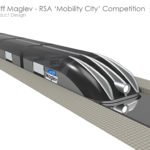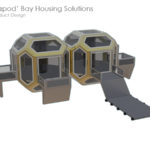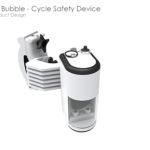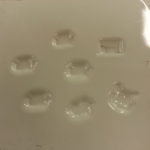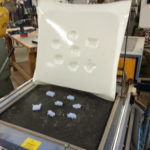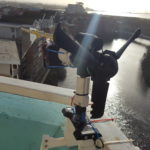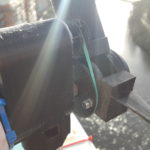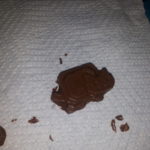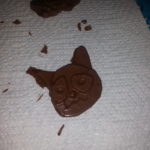Howdy,
Today our collective has been prototyping some moulds for making chocolates using the Makerbot Replicator 3D printer and a vacuum former. Using the shapes Angelo and I have made, we fed the data into the 3D printers and out popped a perfect 3D model for moulding around…
Unfortunately things never really work that way, so today has been a lot of trial and error. Our original designs were the wrong scale and so some scaling had to be done is the makerbot software. Mould depth was also an issue and so I addressed this with some liberal use of the extrude tool, making my 3D printed former a good for millimeters thicker. After the second former was finished, it was immediately obvious that there was a problem actually removing our 3D printed models from the printer’s base. As the plastics is printed directly onto the bed, it can stick (sometimes very solidly) to the base. Once again, I addressed this by making some small supports to hold the model up from the base, making it a lot easier to remove the models from the printer.
Despite the problems, I feel that this was a real learning experience which I have gained a lot of knowledge from. I feel more confident with using the 3D printer now which is incredibly useful for more of my product design projects, where rapid prototyping using these machines will be invaluable. Hands on use with the 3D printer was good fun as well and I feel that I have a better idea of the do’s and don’ts associated with 3D printing, especially knowing when to use rafts and supports.
After completing the formers, we now had to complete the forming. Vacuum forming is a manufacturing method I haven’t used before and so I went into it without any idea what I was doing… To vacuum form, we needed to first find Mike or Keith – our technical demonstrators, who apparently had the only supply of vacuum formable plastics available. Getting the right plastic is highly important, especially considering we have no idea about which plastics are food safe or even capable of being vacuum formed. Thankfully we found two kinds of ABS plastics – 0.5mm thick and 1mm thick.
After testing both plastics, the 1mm thick plastic managed to wrap around the shapes better, though this may have been due to how long we heated the plastics up for and so I think some more tests would be a wise idea. Our final outcomes were to a surprisingly high quality for a first time idea. I cut each shape’s mould out individually to make it easier to use them for pouring chocolate into.
Overall, our day in the workshop has had a considerable outcome, with 7 individual prototype chocolate moulds and the knowledge and potential to create more moulds and different shapes.
Finally, tonight I have now poured some chocolates and started to build up a small batch of chocolates ready for tommorow.


